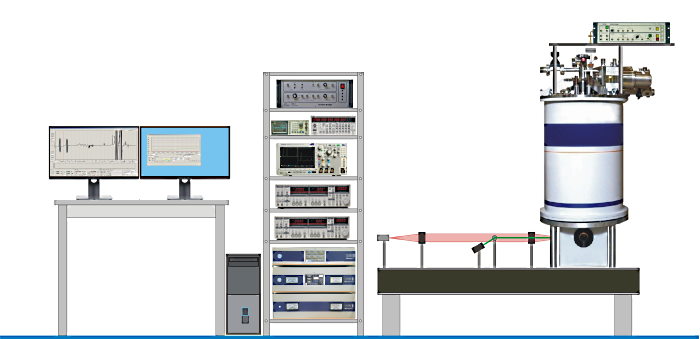Magnetically Insensitive 94 GHz & 130 GHz MM-Wave Bridges Installed for EPR/ODMR spectrometers
- Booklet for download: 94/130 GHz EPR/ODMR spectrometer
- Product page with specs: 94 GHz and 130 GHz Transceiver Units for EPR ODMR Spectrometers
ELVA-1 developed and delivered microwave bridges (transceivers) operating at 94 GHz (W-band) and 130 GHz (D-band) for the EPR-ODMR spectrometer developed for the Microwave Crystal Spectroscopy Laboratory.

The EPR-ODMR spectrometer is based on the use of the effects of electron paramagnetic resonance (EPR) and optically detectable magnetic resonance (ODMR). This spectrometer helps to research the magneto-optical properties of various materials.
Measurement results are used in many areas of theoretical and applied science:
- Non-destructive diagnostics of condensed matter;
- Studying the nature of photosynthesis, biological processes, metal proteins, free radicals;
- Development of new types of drugs;
- Exploration of raw materials, including analysis of oil-bearing fields;
- Application in dosimetry;
- In the study and control of materials promising in photovoltaics (the conversion of sunlight into electrical energy);
- In research on spin manipulation in spintronics and quantum information technologies, devices based on nanostructures and single quantum objects.

The development trend of EPR-ODMR spectroscopy is to move into the field of higher magnetic fields and higher values of microwave frequencies. At the same time, it becomes possible to obtain EPR-ODMR spectrum with a higher frequency resolution (or magnetic field), which allows a more detailed study of the properties of the samples under study.
Microwave bridges 94 GHz and 130 GHz are the best world models of such equipment:
- For reliable and accurate experiments
- Assembled on semiconductor elements insensitive to the magnetic field. The strong field of the superconducting magnet does not significantly affect their operation.
- Easy change of the operating frequency of the spectrometer between 94 GHz and 130 GHz because of a unified scheme for connecting microwave bridges to the spectrometer;
- High technical specs of microwave bridges:
- High stability of the operating frequency (~ 10 ^ (- 6) 1 / degree C) and low phase noise of a high-frequency signal (~ (-100 dBc / Hz) at a detuning of 10 kHz) allow recording high-resolution spectra of the magnetic field, up to μT units;
- High output power of the transmitting channel ensures the possibility of using short pulses up to 10 ns for measuring paramagnetic centers;
- Sensitive superheterodyne receiver allows detecting a low concentration of spin centers up to 10 ^ (8) -10 ^ (9) centers / G;
- Compact instrument housings are easy to install nearby the cryostat.
The EPR-ODMR spectrometer includes:
- Microwave bridges 94 GHz and 130 GHz for irradiating a sample and receiving a signal of resonant phenomena;
- Helium cryostat with superconducting magnetic windings. The test samples are placed inside the cryostat and can be at a temperature close to absolute zero;
- The source of visible radiation and a detector of optical resonance phenomena;
- Additional modules as temperature and magnetic field controllers, LF and DEYAR generators, amplifiers, ADC module, waveguide system;
- Computer system for recording of measurement results.
From this point of view, spectrometers with operating frequencies of 94 GHz and 130 GHz are a kind of compromise. They provide a fairly high accuracy of spectral measurements and at the same time have a reasonable cost. It should be noted that a significant (~ 50%) contribution to the cost of the spectrometer is made by a cryostat with superconducting magnetic coils.
“Millimeter bridges have very high stability of the output frequency, a short wave path. Devices can be installed directly above the cryostat without fear of interference from its magnetic field. They are convenient to use, they provide a simple and quick change of the operating frequency. The high output frequency of the transmitter provides sensitivity in the ODMR mode from the level of 103-102 spins to a single spin. We have obtained high spectral resolution for the EPR mode, double electron nuclear resonance (DEAR), cyclotron resonance, high resolution for studying the anisotropic properties of the samples, and also excellent characteristics for a number of other parameters,” -from customer’s review.
